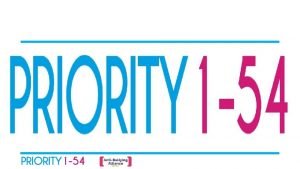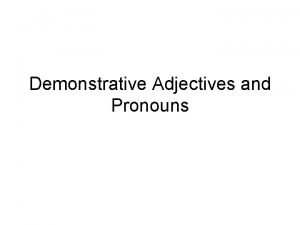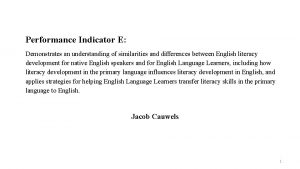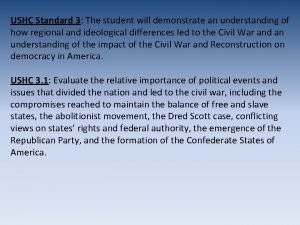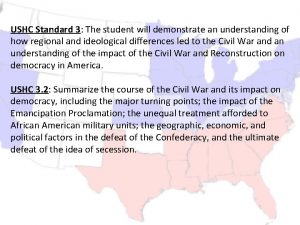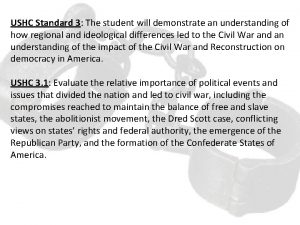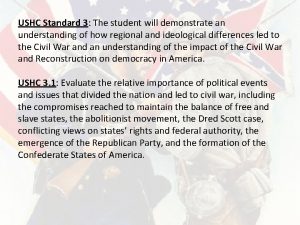USHC Standard 6 The student will demonstrate an












- Slides: 12

USHC Standard 6: The student will demonstrate an understanding of the conflict between traditionalism and progressivism in the 1920 s and the economic collapse and the political response to the economic crisis in the 1930 s. USHC Standard 6. 3: Explain the causes and consequences of the Great Depression, including the disparities in income and wealth distribution; the collapse of the farm economy and the effects of the Dust Bowl; limited governmental regulation; taxes, investment; and stock market speculation; policies of the federal government and the Federal Reserve System; and the effects of the Depression on the people. Created by Mrs. Magyar

The Great Depression

The Great Depression • The stock market crash was not the cause of the Great Depression, but rather an outward sign of long term problems within the economy • The stock market crash, in 1929, signaled the beginning of the Depression • The Depression lasted over a period of years, spiraling deeper and deeper until massive government spending in WWII ended it

The Great Depression The basic problems in the economy, leading to the depression, were declining demand overproduction

The Great Depression • The 1920’s seemed prosperous, with high employment rates and almost no inflation – This was a false prosperity • The disparity in incomes, and the distribution of wealth was very large and uneven – The gap between the rich and the poor widened during the Great Depression – The wealthiest Americans had a far greater share of disposable income – The great majority of Americans lived below the poverty line

The Great Depression • The majority of workers could not actually afford to buy the products they manufactured – Companies were not passing on prosperity to their employees • When consumers reached their limit of installment payments, they had to stop spending • The drop in consumer spending led to lay-offs and furthered the inability for workers to spend POVERTY AND DEBT HAVE A CYCLICAL NATURE

The Great Depression • The farm economy in the U. S. collapsed during the 1920’s • Farmers who had prospered in war years now faced problems: – – International competition Depressed prices Debts Taxes • Farmers defaults on bank loans caused many banks to fail before the crash – these bank failures limited the number of loans available for small businesses which then could not expand or hire

The Great Depression • Republican administrations in the 1920’s limited government regulation on “Big Business” – Corporations became increasingly powerful – The tariff was raised – The wealthy received tax breaks on their income tax • This did not help the economy – The wealthy spent most of their income on luxury goods – This did not make up for the loss of spending power for the great majority of American people

The Great Depression • Wealthy Americans put most of their tax savings into investments in the stock market • Investments in the stock market drove up speculation in businesses – These businesses could not sustain profits, because consumer demand was decreasing • This resulted in excessive inventories • At the end of the 1920’s, businesses cut back production • Companies invested their money in stock market speculation, instead of in production • Investors, noting the large inventories, began to reconsider their investments

The Great Depression • Stock market speculation and the “get rich quick” mentality led to inflated stock values and eventually to a crash – Buying on the margin: Investors were allowed to borrow on the paper value of their stock, in order to buy more stock – An unusual number of sell order kicked the bottom out of the market in 1929 – Brokerage firms demanded their margin loans be repaid – Investors were forced to sell at low prices to meet their obligations, and stock prices plunged

The Great Depression • Prominent bankers helped to prop up the market for several days, but public confidence was shattered • “Black Tuesday”: Oct. 29, 1929; the market experienced the greatest crash in its history THIS SYMBOLIZED THE END OF THE FALSE PROSPERITY OF THE 1920’s

 Touching spirit bear chapter 11 summary
Touching spirit bear chapter 11 summary Cna chapter 6 personal care skills
Cna chapter 6 personal care skills Demonstrate rhyme
Demonstrate rhyme Demonstrate
Demonstrate Imbricate
Imbricate What does this image demonstrate
What does this image demonstrate Demonstrate
Demonstrate Human hair roots demonstrate a wineglass morphology.
Human hair roots demonstrate a wineglass morphology. Mt carmel contest
Mt carmel contest Demonstrate two
Demonstrate two Examples demonstrative adjectives
Examples demonstrative adjectives Demonstrate knowledge and understanding
Demonstrate knowledge and understanding Demonstrate
Demonstrate









